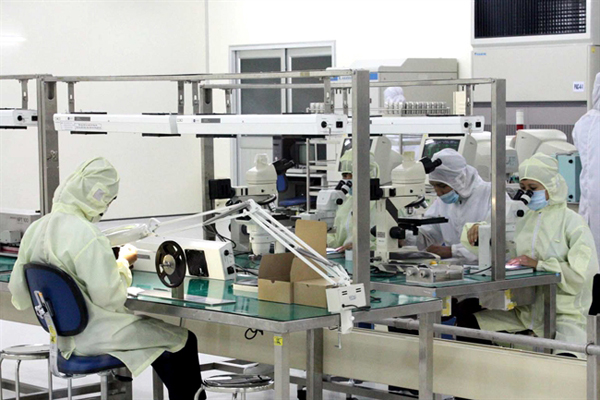
The southern province of Binh Duong recorded a year-on-year growth rate of 7 percent in gross regional domestic product (GRDP) between January and June, according to the provincial People’s Committee.
Producing electronic
components at the Japanese-invested Seibi Semiconductor Vietnam Co. Ltd in the
VSIP II Industrial Park in Binh Duong (Photo: VNA)
The figure was lower than that of the same
period last year, which had grown 7.85 percent since the first half of 2016.
Meanwhile, the province targets a GRDP expansion of 8.5 percent by the end of
2018.
Over the last six months, the local industrial sector grew 8.3 percent, the
services sector expanded 5.3 percent, and agro-forestry-fishery increased by
3.5 percent.
The industrial production index rose by 8.9 percent with processing activities
posting the fastest pace of 9.2 percent. Total retail sales of goods and
services were estimated at 92.21 trillion VND (3.97 billion USD), up 17 percent
year-on-year.
Provincial authorities also reported good growth in Binh Duong’s import and
export revenue, resulting in a trade surplus of 2.5 billion USD in the first
half of this year.
Foreign investors poured more than 854 million USD into the province, which was
61 percent of this year’s plan, but only 49 percent of that for the same period
of 2017.
Chairman of the provincial People’s Committee Tran Thanh Liem said that in
order to fulfil this year’s targets, the administration will devise measures
for improving the investment climate, facilitating production and business
activities in each sector to fuel economic growth.
Binh Duong will also step up dialogue with enterprises and business
associations to tackle hindrances to their operations, as well as supporting
startups and innovation activities. It will also work out suitable solutions to
encourage household businesses, cooperatives, and cooperative groups to
transform into enterprises, he added.
Binh Duong is part of Vietnam’s southern key economic region, which also
includes Ho Chi Minh City, and the provinces of Tay Ninh, Binh Phuoc, Dong Nai,
Ba Ria-Vung Tau, Long An, and Tien Giang. -
Source: VNA
According to data from the Hoa Binh Provincial Party Committee, the industrial production index for the first six months of 2025 is estimated to have increased by 20% compared to the same period last year. This marks the highest year-on-year growth rate for this period since 2020.
In the first six months of 2025, Hoa Binh province’s export turnover was estimated at 1.145 billion USD, marking an 18.11% increase compared to the same period in 2024. Import turnover was estimated at $ 804 million, a 17.15% increase, which helped the province maintain a positive trade balance.
The lives of the ethnic minority farmers in Tan Lac district have gradually improved thanks to the new directions in agricultural production. This is a testament to the collective strength fostered through the professional associations and groups implemented by various levels of the district’s Farmers’ Union.
With the motto the "product quality comes first,” after nearly one year of establishment and operation, Muong village’s Clean Food Agricultural and Commercial Cooperative, located in Cau Hamlet, Hung Son Commune (Kim Boi district), has launched reputable, high-quality agricultural products to the market that are well-received by consumers. The products such as Muong village’s pork sausage, salt-cured chicken, and salt-cured pork hocks have gradually carved out a place in the market and they are on the path to obtaining the OCOP certification.
In the past, the phrase "bumper harvest, rock-bottom prices" was a familiar refrain for Vietnamese farmers engaged in fragmented, small-scale agriculture. But today, a new spirit is emerging across rural areas of Hoa Binh province - one of collaboration, organisation, and collective economic models that provide a stable foundation for production.
Maintaining growing area codes and packing facility codes in accordance with regulations is a mandatory requirement for agricultural products to be eligible for export. Recently, the Department of Agriculture and Environment of Hoa Binh province has intensified technical supervision of designated farming areas and packing facilities to safeguard the "green passport" that enables its products to access international markets.



